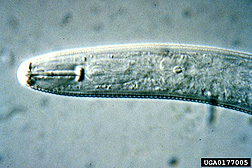This page has been archived and is being provided for reference purposes only. The page is no longer being updated, and therefore, links on the page may be invalid.
|
|
Scientists Aim to Spike Pest's Biochemical Punch Bowl
By Jan SuszkiwJanuary 7, 2009
Tiny, wormlike organisms called nematodes can be friend or foe to farmers. One such foe, the soybean cyst nematode Heterodera glycines, costs soybean farmers $1 billion annually in crop losses and chemical controls. But now, the crop pests could become their own worst enemies, thanks to biochemical sabotage.
Agricultural Research Service (ARS) physiologist Edward Masler is developing this strategy at the agency's Nematology Laboratory in Beltsville, Md. He's investigating molecules produced by the nematodes that could be used to subvert their feeding, mating or other behaviors.
Masler's research with biogenic amines and other biochemicals is part of a long-term effort to devise environmentally friendly alternatives to conventional pesticides, particularly the fumigant methyl bromide, which is restricted for all but critical uses because of its toxicity.
Masler also is targeting the root-knot nematode Meloidogyne incognita, which infests peanut, potato, cotton and other crops. The knot-like feeding site each nematode forms on host-crop roots restricts the plant's access to nutrients, causing stunted growth, diminished yields and other harm.
Since the mid-1990s, Masler has scrutinized the biochemistry of these and other nematode crop pests for clues to disrupting such destructive behavior. Biogenic amines, a recent focus, occur in other living organisms. So, Masler must ensure their biological activity is restricted solely to Heterodera and Meloidogyne nematodes.
In laboratory experiments, he exposed juvenile nematodes and unhatched eggs to an "overdose" of one of three amines--dopamine, octopamine and serotonin--and monitored the effects. Interestingly, 90 percent of Heterodera eggs failed to hatch after exposure to serotonin, versus 40 percent for Meloidogyne. In juveniles of both species, serotonin exposure decreased head-swinging--a foraging behavior--while dopamine increased it.
Ultimately, such observations could predict the amines' usefulness as natural agents for controlling the pests under field conditions.
Proteolytic enzymes offer another potential target. Normally, they act as cellular brakes that stop the signaling of neuropeptides called FLPs. Masler is exploring whether removing those "enzymatic brake pads" could cause FLPs to build to levels that will incapacitate the nematodes, offering yet another alternative to chemically controlling them.
ARS is a scientific research agency of the U.S. Department of Agriculture.

